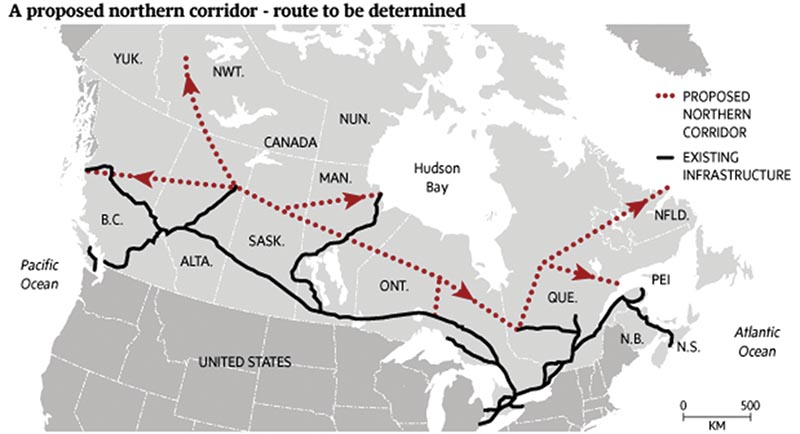– Senate committee aims to put northern corridor on the map
Senator David Tkachuk, Saskatchewan
Two major challenges have plagued Canada since its earliest days – how to move an unparalleled wealth in natural resources across an immense landmass and how to improve quality of life in the country’s most remote areas. A northern corridor would offer a solution to these in the form of a great, new national project.
Late in 2016, the Senate Committee on Banking, Trade and Commerce began a study on the development of a national corridor – an idea put forward in a 2016 report by the University of Calgary and CIRANO, an interuniversity research group based in Montreal.
Over the course of the committee’s hearings, we learned that nearly 50 years earlier, Richard Rohmer, an honorary air force general and lawyer, conducted a study with engineering firm Acres Research that proposed a mid-Canada corridor. It was presented in 1971 to a prime minister who, as it happens, was named Trudeau.
It has been sitting on the shelf, gathering dust, ever since.
“A 7,000-kilometre transportation corridor, the project would establish a right of way across the country, accommodating highways, railways, pipelines as well as electrical transmission and communications networks.”
In our report we compared the building of a national corridor, specifically a northern corridor, to the building of that other great national project, the Canadian Pacific Railway, undertaken by
Sir John A. Macdonald. A 7,000-kilometre transportation corridor, the project would establish a right of way across the country, accommodating highways, railways, pipelines as well as electrical transmission and communications networks. Among its many benefits, it would help:
• Diversify our markets
• Enhance economic growth and job creation
• Benefit indigenous people, who should be full business partners in the project
• Decrease traffic on the country’s southern transportation networks and
• Support Canada’s sovereignty in the Arctic.
The number of compelling reasons for building a national corridor goes on. And nearly everyone agrees it should be built. But the committee’s fear is that 50 years from now, our report will be sitting on a shelf gathering dust and still no corridor will have been built – no matter how much economic sense it makes.
Perhaps the current political leadership lacks the vision of a
Sir John A. Macdonald. Perhaps there is no paramount need to bring the country together today as there was in his day. It is undeniable that in John A.’s day, an ever-expanding United States, with its eyes on moving north, threatened British North America with encirclement and annexation.
Today’s politicians tout the benefits of free trade abroad but cannot organize it among its provinces at home. By some estimates, the barriers to internal trade are costing our economy somewhere between $50 to 130 billion a year.
If we can’t open our own internal borders with that kind of incentive, and with a section of the Constitution (Section 121) guaranteeing the free flow of goods among the provinces, supposedly paving the way for federal action, how do we expect to build a corridor across provincial and territorial jurisdictions to ship goods unfettered across the country?
We live in times when a former mayor of Montreal, one of Canada’s largest cities, celebrated not building the Energy East pipeline, something that would benefit the entire country, including his own province.
It’s time to reverse this worrying trend.
A good start would be for the federal government to provide the University of Calgary and CIRANO with $5 million to complete their study on a corridor. We recommended that expenditure in the banking committee’s report.
We tabled our report in the Senate in May (well over six months ago) and there is still no sign of the government moving on our recommendation. Quite the opposite, in fact.
While we were conducting our study, as chair of the committee, I wrote to several ministers asking them to provide funding to the University of Calgary. They either passed the buck or flat out refused: The Transport Minister Marc Garneau wrote: “At present, Transport Canada is not in a position to commit funding for a study such as the one proposed by the University of Calgary’s School
of Public Policy.”
What groups like the Association of Consulting Engineering Companies need to do is bring the urgency and excitement they feel about a national corridor to the attention of their local MPs. And don’t let up.


 1-866-985-9780
1-866-985-9780








